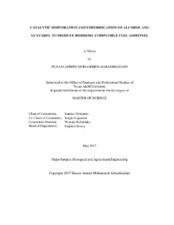| dc.description.abstract | Global glycerol supplies have been increasing steadily due to the continual expansion of biodiesel production. This glut has resulted in lower demand for glycerol, price deflation and even environmental concerns. Crude glycerol produced from biodiesel transesterification is not of high quality due to catalyst and alcohol contamination and transportation and disposal issues—all of which have added further constraints to this industry. In light of this, a product that could utilize glycerol, excess alcohol and the catalyst could enhance the value proposition for the biodiesel industry. Here, we show that glycerol can be reacted with methanol and tert-butanol in the presence of common transesterification catalysts to produce an ether-rich mixture that is miscible with biodiesel. Initially, the bimolecular dehydration of two alcohols, n-propanol and methanol, with catalysts that are used in transesterification was investigated. Experiments were carried out to evaluate the feasibility of promoting the etherification reaction using methanol and n-propanol as model alcohols. When methanol and npropanol are reacted together, three types of ethers can be produced: dimethyl ether, methyl-propyl ether (also referred to as methoxypropane), and di-propyl ether. The latter two ethers are of more fuel interest due to their ability to stay in the liquid phase at room temperature; however, the ability of catalysts to selectively produce liquid ethers is not established.
Initial studies were conducted to discern the effect of sulfuric acid, amberlyst-36 and titanium isopropoxide—catalysts that are known to be effective for transesterification— on the substrate conversion, ether yield, and selectivity using n-propanol at four levels of temperature. Subsequent studies with n-propanol and methanol looked at the impact of select catalyst concentrations and reaction conditions. Studies indicate that liquid mixtures of 1-methoxypropane and di-propyl ethers could be formed by reacting npropanol and methanol in the presence of sulfuric acid or Amberlyst 36. Higher concentrations of sulfuric acid (5% w/w) coupled with higher temperatures (>140oC) favored substrate conversion and ether yields. However, it was revealed that the selectivity toward specific ethers (i.e. coupling of the two larger alcohols to produce dipropyl ether) could be controlled by appropriate selection of the catalyst. It is anticipated that the results would be a starting point for a simple technique to produce specific ethers using a mixture of alcohols. This technique could be applied for applications such as transesterification byproduct utilization. Subsequent studies where glycerol was used as one of the primary alcohols looked at the impact of type and concentration of catalysts, molar ratio of reactants, temperature, and reaction time on alcohol conversion, product yield, selectivity and select fuel properties. Results show that both NaOH and H2SO4 are active for producing etherified blends from glycerol that are miscible with biodiesel. These results could be a starting point for the development of an effective fuel additive to reuse the byproduct glycerol and excess alcohol resulting from biodiesel production. | en |


